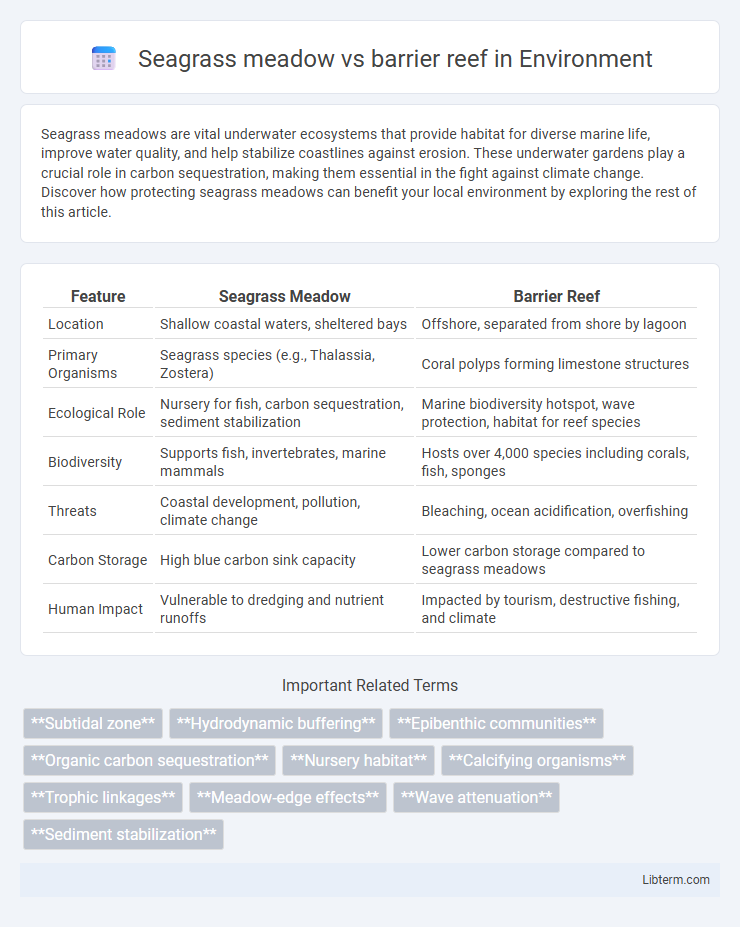Seagrass meadows are vital underwater ecosystems that provide habitat for diverse marine life, improve water quality, and help stabilize coastlines against erosion. These underwater gardens play a crucial role in carbon sequestration, making them essential in the fight against climate change. Discover how protecting seagrass meadows can benefit your local environment by exploring the rest of this article.
Table of Comparison
| Feature | Seagrass Meadow | Barrier Reef |
|---|---|---|
| Location | Shallow coastal waters, sheltered bays | Offshore, separated from shore by lagoon |
| Primary Organisms | Seagrass species (e.g., Thalassia, Zostera) | Coral polyps forming limestone structures |
| Ecological Role | Nursery for fish, carbon sequestration, sediment stabilization | Marine biodiversity hotspot, wave protection, habitat for reef species |
| Biodiversity | Supports fish, invertebrates, marine mammals | Hosts over 4,000 species including corals, fish, sponges |
| Threats | Coastal development, pollution, climate change | Bleaching, ocean acidification, overfishing |
| Carbon Storage | High blue carbon sink capacity | Lower carbon storage compared to seagrass meadows |
| Human Impact | Vulnerable to dredging and nutrient runoffs | Impacted by tourism, destructive fishing, and climate |
Introduction to Seagrass Meadows and Barrier Reefs
Seagrass meadows are underwater ecosystems composed of flowering plants that provide essential habitats for marine life, enhance water quality, and stabilize sediment. Barrier reefs, among the largest and most complex coral reef systems, create natural coastal protection by buffering wave energy and supporting diverse marine biodiversity. Both ecosystems play crucial roles in coastal resilience and marine productivity, but they differ fundamentally in composition and ecological function.
Geographical Distribution and Habitats
Seagrass meadows predominantly occur in shallow coastal waters across all continents except Antarctica, often thriving in sheltered bays, estuaries, and lagoons with soft sediment substrates. Barrier reefs are primarily found in tropical and subtropical oceanic regions, particularly along continental shelves, where clear, warm waters facilitate coral growth on rigid limestone structures. The contrasting habitats highlight seagrass meadows' role in coastal sediment stabilization while barrier reefs form extensive coral frameworks supporting diverse marine ecosystems.
Biological Structure and Composition
Seagrass meadows consist primarily of marine angiosperms with dense root systems stabilizing sediment and providing habitat for numerous invertebrates and fish species, characterized by leafy shoots and rhizomes. In contrast, barrier reefs are composed mainly of calcium carbonate structures built by symbiotic relationship-sensitive corals, hosting diverse coral polyps, sponges, and algae forming complex three-dimensional frameworks. While seagrass meadows rely on photosynthetic plants for primary production, barrier reefs depend on reef-building corals and zooxanthellae algae for nutrient cycling and structural formation.
Ecosystem Services and Benefits
Seagrass meadows provide critical ecosystem services such as carbon sequestration, sediment stabilization, and nursery habitats for fish and invertebrates, enhancing coastal water quality and supporting fisheries. Barrier reefs offer coastal protection by dissipating wave energy, maintaining biodiversity hotspots with complex coral structures, and supporting tourism-driven economies through recreational activities. Both ecosystems contribute significantly to marine carbon cycling but differ in their physical roles: seagrass meadows stabilize substrates, while barrier reefs act as natural breakwaters.
Biodiversity and Key Species
Seagrass meadows support diverse marine life including juvenile fish, crustaceans, and dugongs, providing crucial nursery habitats and enhancing local biodiversity. Barrier reefs host an extensive range of coral species, reef fish, mollusks, and sponges, acting as global biodiversity hotspots with over 4,000 fish species documented in the Great Barrier Reef alone. Both ecosystems play vital roles in sustaining marine food webs and maintaining ecological balance in coastal environments.
Role in Coastal Protection
Seagrass meadows stabilize sediment and reduce wave energy, preventing coastal erosion and enhancing water clarity by trapping particles. Barrier reefs serve as natural breakwaters, dissipating wave energy before it reaches the shore and protecting coastlines from storm surges and high waves. Both ecosystems are crucial in mitigating coastal damage, supporting biodiversity, and preserving shoreline integrity.
Carbon Sequestration and Climate Impact
Seagrass meadows excel in carbon sequestration by capturing and storing large amounts of blue carbon in their sediment, often sequestering carbon up to 35 times faster than tropical rainforests. Barrier reefs, while vital for coastal protection and biodiversity, sequester carbon mainly through calcium carbonate deposition, which can release CO2 during calcification, making their net climate impact less favorable than seagrass beds. The preservation and restoration of seagrass meadows are crucial for mitigating climate change due to their high carbon storage efficiency and long-term carbon burial potential.
Threats and Environmental Challenges
Seagrass meadows face threats from coastal development, water pollution, and sedimentation, leading to habitat loss and reduced water quality. Barrier reefs are primarily endangered by coral bleaching caused by rising sea temperatures, ocean acidification, and physical damage from storms and human activities. Both ecosystems suffer from nutrient runoff and invasive species, which disrupt ecological balance and threaten biodiversity.
Conservation Strategies and Management
Seagrass meadows require conservation strategies emphasizing nutrient pollution control, sediment management, and protection from coastal development to maintain their role in carbon sequestration and habitat provision. Barrier reefs demand management approaches that include regulating fishing activities, mitigating coral bleaching through climate action, and establishing marine protected areas to preserve biodiversity and reef resilience. Integrating community engagement and monitoring programs is essential for both ecosystems to ensure long-term sustainability and adaptive management.
Future Outlook and Comparative Importance
Seagrass meadows and barrier reefs both play critical roles in coastal ecosystem health and climate resilience, with seagrass meadows offering substantial carbon sequestration benefits and supporting biodiversity as nursery habitats. Barrier reefs provide essential coastal protection and sustain fisheries, but face greater immediate threats from bleaching and acidification due to climate change. Future conservation efforts must balance the preservation and restoration of both habitats to maximize ecological services and safeguard marine biodiversity against increasing environmental pressures.
Seagrass meadow Infographic

 libterm.com
libterm.com